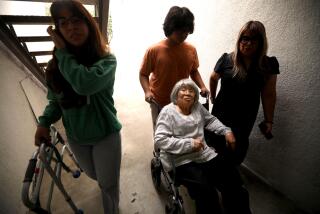The Inns and Outs of Living in a Nursing Home
- Share via
Let’s face it. We’re all aging, and many of us are going to live long enough to spend our last years in nursing homes. We hope we’ll be tended by compassionate caregivers who have only our best and individual interests at heart, but given the nightmarish stories we hear about some nursing homes, it’s important to become familiar with an environment in which our parents, our spouses, our partners or ourselves eventually may live.
This book, written by a Canadian social worker, examines not only the various stages of aging and loss of control, but the psychological issues and deep emotions affecting friends, family members, primary caregivers, out-of-town caregivers and nursing home residents themselves. There are scores of legal, medical and financial considerations to work out when someone can no longer live at home. And then there are the day-to-day considerations such as doing laundry, building new relationships, dealing with roommates, asking for help and finding privacy in a semi-public setting.
Among the most valuable chapters in this book is one titled “Making a Home Better,” which includes wonderful advice on how a loved one can influence what goes on inside a nursing home, beginning with involving the affected resident in changes. Silin is practical, recognizing that loved ones who donate time or money to a nursing home can affect what happens when they’re not there. He encourages working with other families, emphasizes finding ways to build on the good things the facility may be doing and reminds readers that when it comes to people and organizations, “change doesn’t happen overnight.” His inclusion of real-life stories from the families he’s encountered over 20 years anchors the book compassionately.
MAYO CLINIC ON MANAGING DIABETES
Practical Answers to Help You Enjoy a Healthy and Active Life
Dr. Maria Collazo-Clavell, editor in chief
Mayo Clinic
194 pages, $14.95
More than 16 million Americans suffer from diabetes, an incurable condition in which the body can’t properly process sugar and carbohydrates, but only half have managed to get their sugar levels under control. With the nation growing fatter by the day and the increase in obesity leading to skyrocketing rates of diabetes, this is one condition that touches someone in everyone’s life.
Those who have the illness, or are trying to help and offer support to someone who does, could benefit greatly from this book. Using simple, direct and understandable language, supplemented by helpful diagrams, this book walks a reader through all major aspects of the illness--from what it is and how to deal with crises to coping with nerve damage and sexual dysfunction.
After introducing diabetes, its warning signs, symptoms and consequences, the book addresses how to take control by monitoring blood sugar, developing good eating habits, exercising and getting to a good weight. All types of medication, from the oral agents to insulin injections, are discussed, their mechanisms explained and their uses carefully described. Although there is no treatment yet that can completely reverse diabetes, the book walks readers through pancreatic transplantations and still-experimental transplants of islet cells, which produce insulin. Each section concludes with common questions and answers. This is a handy, comprehensive guide.
More to Read
Sign up for our Book Club newsletter
Get the latest news, events and more from the Los Angeles Times Book Club, and help us get L.A. reading and talking.
You may occasionally receive promotional content from the Los Angeles Times.









